
1855
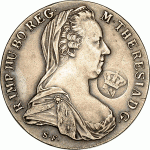
In the 18th and 19th centuries, Maria Theresa thalers and blocks of salt called amole tchew (አሞሌ) served as currency in Ethiopia. The thaler was known locally as the birr (literally ‘silver’ in Geʽez and Amharic) or talari (ታላሪ). The Maria Theresa thaler was officially adopted as the standard coin in 1855, although the Indian rupee and the Mexican dollar were also used in foreign trade.
1893
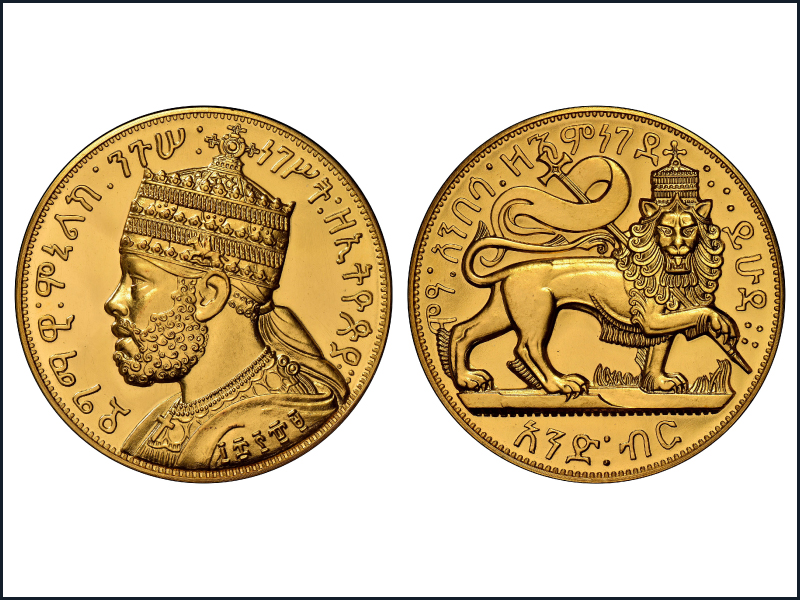
The Ethiopian talari became the standard unit on 9 February 1893, and 200,000 were produced at the Paris Mint in 1894 for Menelik II. The talari, equivalent to the Maria Theresa thaler, was divided into 20 ghersh (also guerche or gersh, from the Ottoman qirsh) or 40 bessa (a small copper coin).
1903
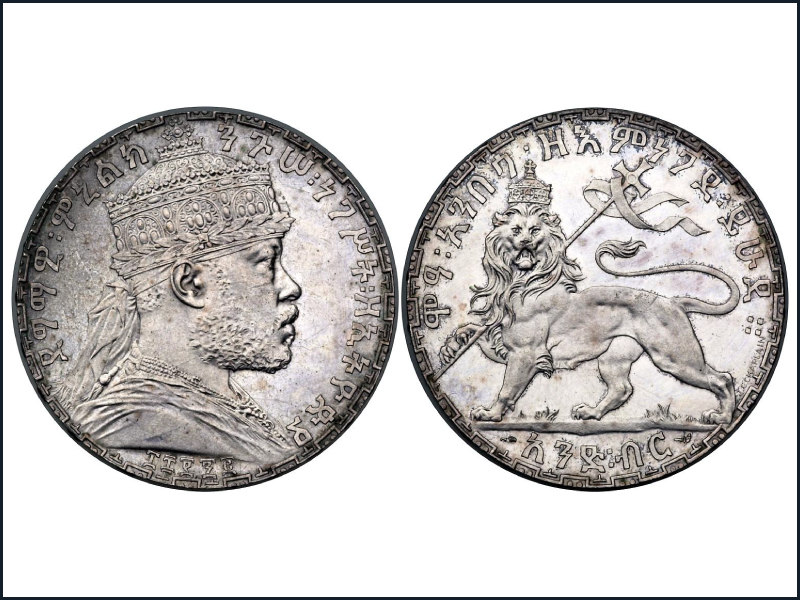
A new Ethiopian coinage appeared about 1903. The new silver birr maintained the same weight and fineness as the talari, but there was now a quarter-birr and a silver ghersh, the latter 1/16 the weight of the birr. The money of account then became 1 birr, equivalent to 16 ghersh or 32 bessa.
1915
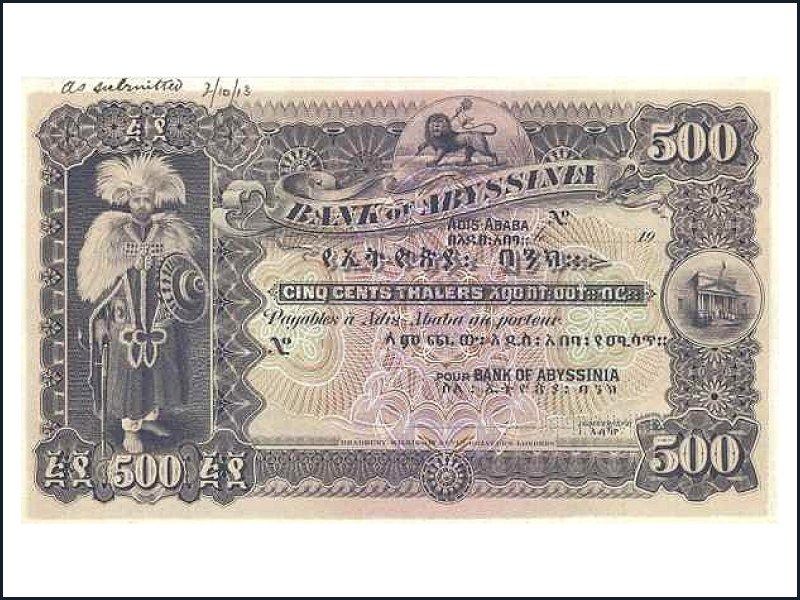
The Ethiopian coinage gained acceptance only gradually, and the Bank of Abyssinia imported Maria Theresa thalers. By the time World War I broke out, the bank was still importing about 1,200,000 of these coins annually. The Bank of Abyssinia put banknotes into circulation in 1915. These notes were denominated birr in Amharic and thaler in English. They were used by merchants and foreigners but were not initially accepted generally. However, note circulation increased considerably after 1925.
1931-1936
In 1931, Emperor Haile Selassie I formally requested that the international community use the name Ethiopia (as it had already been known internally for at least 1,600 years) instead of the exonym Abyssinia, and the issuing Bank of Abyssinia also became the Bank of Ethiopia. Thus, the pre-1931 currency could be considered the Abyssinian birr and the post-1931 currency the Ethiopian birr, although it was the same country and the same currency before and after.
Emperor Haile Selassie bought out the Bank of Abyssinia in 1931 for £235,000 in order to make it a purely Ethiopian institution. It was reorganized as Bank of Ethiopia. At the same time, the currency was decimalized and token nickel and copper coins were introduced, the birr becoming equal to 100 metonnyas (often written matonas). The text on the bank’s notes appeared in Amharic, French, and English.
By the mid-1930s circulation consisted chiefly of Maria Theresa and Menelik talari.
1936-41
1941-45
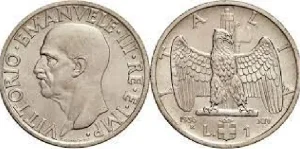
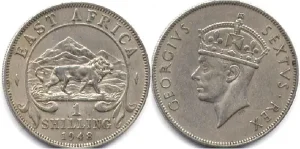
Not long after the Italian occupation and the attempted transformation of Ethiopia into Italian East Africa, the Italian lira was introduced on 15 July 1936 and Ethiopian banknotes were withdrawn from circulation at 3 lire per talari (birr). In an effort to increase the use of Italian paper money, the exchange rate for silver coins (Maria Theresa thalers) was raised to 4.50 lire, then to 5.00, and eventually, in stages, to 13.50. Still, many people kept their Ethiopian coins and banknotes.
Regular Italian coins and banknotes of Banca d’Italia circulated after 15 July 1936. Special notes with a red overprint were authorized for Italian East Africa on 12 September 1938, and a large quantity was printed. It is not clear, however, when, where, and to what extent these special notes actually circulated
During the East African Campaign of 1941, British forces brought with them Indian, Egyptian, British, and British East African currency, and all were received in official payments. Italian coins and notes of up to 50 lire were allowed to continue in circulation to serve as small change; higher denominations were withdrawn at a rate of 24 lire per shilling. Maria Theresa thalers were allowed to circulate with a value of 1 shilling and 10+1⁄2 pence (or 45 lire). The East African shilling became the money of account on 1 July 1942; it eventually became the sole legal tender and remained so until 1945.
Regular notes of the East African Currency Board were used for circulation in Ethiopia.
1945-1976
On 23 July 1945, notes were introduced by the Bank of Ethiopia in denominations of 1, 5, 10, 50, 100 and 500 birr. The National Bank of Ethiopia was established by imperial proclamation 207 of 27 July 1963, and began operation on 1 January 1964. The National Bank of Ethiopia took over note production in 1966 and issued all denominations except for the 500 birr.
In 1944 (EE1936 in the Ethiopian calendar), coins were reintroduced, with copper 1, 5, 10 and 25 santim and silver 50 santim coins.
1977-1991
On September 1976, new notes were issued that fully changed the features of the emperor notes. These currencies remained in use till 1997.
A second series of coins was issued in 1977 (EE1969). It consisted of aluminium 1 santim, brass 5 and 10 santim, cupro-nickel 25 and 50 santim, and bi-metallic 1 birr.A second series of coins was issued in 1977 (EE1969). It consisted of aluminium 1 santim, brass 5 and 10 santim, cupro-nickel 25 and 50 santim, and bi-metallic 1 birr.
1991-2020
In November 1997, a new series of were issued with minor features and color changes. The higher denominations, that is, 50 and 100 birr received improved security features. A modern 1 birr coin was struck to replace the banknote of the same denomination.
2020-
On September 14, 2020, new currency notes were introduced, with enhanced security features and other distinctive elements. The new currency notes replaced the 10, 50 and 100 bill notes while an additional 200 birr note was introduced.
The notes are reflective of the natural, historical features of the country besides anticipating the future strategies like industrialization and modern agriculture.